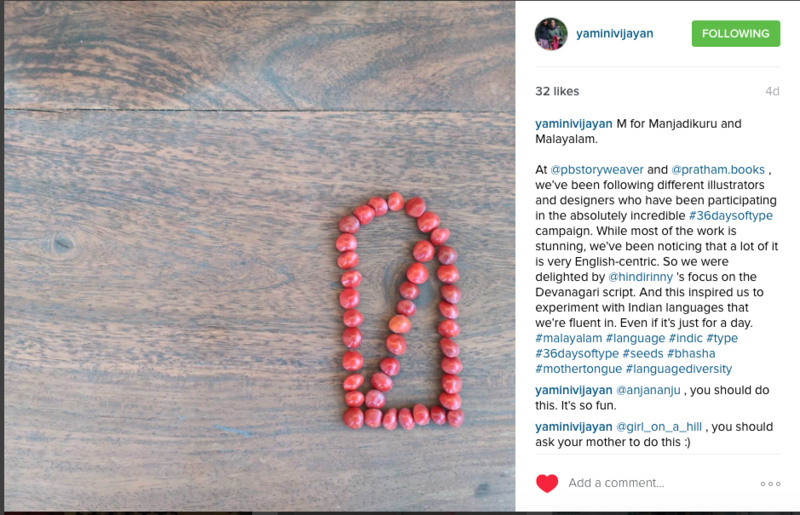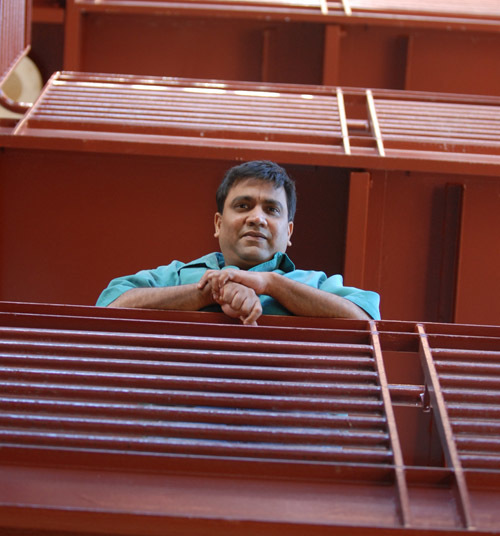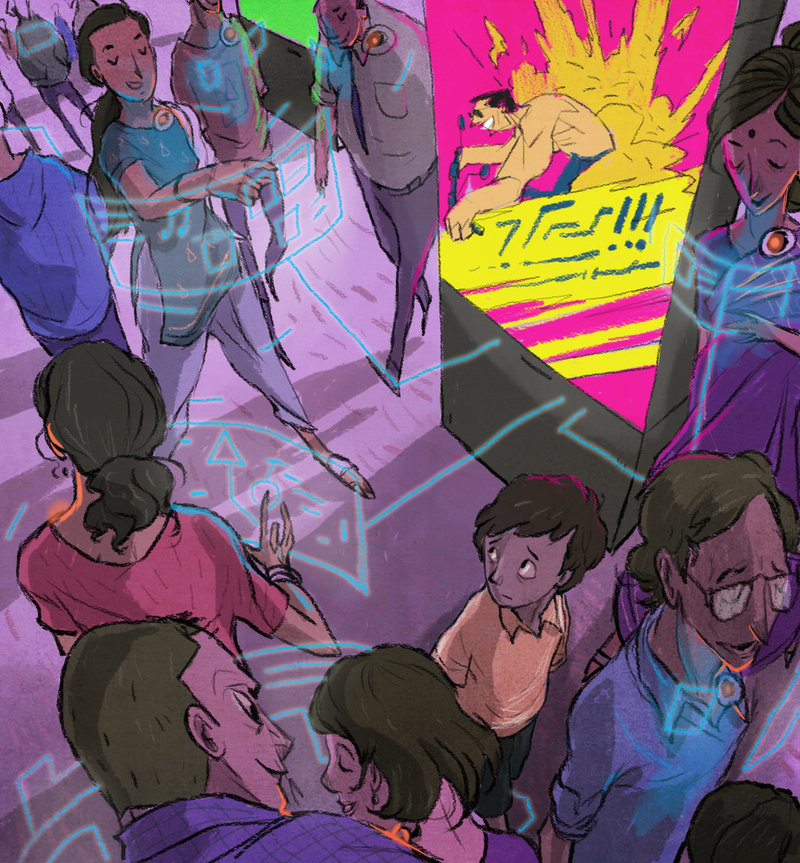அ आ ಇ
Posted by Remya Padmadas on May 02, 2016StoryWeaver has been blown away by the amazing work being shared on Instagram @36daysoftype.
"36days is a yearly open call inviting designers, illustrators and visual artists to share their view on the letters and numbers from our alphabet."
We noticed that most people were taking part in English till a colleague pointed us to @HindiRinny who was doing fabulous things in the Devanagari script. Check out this awesome video:
We thought it would be amazing if we (and that means you too!) could start contributing an alphabet in a language we're fluent in, designed creatively.
Take a look at what our Content Manager, Yamini Vijayan shared: മ for Manjadikuru.

You could share these from your own Twitter, Instagram or Facebook handles and tag us @PBStoryWeaver or email a picture at [email protected].
Looking forward to some amazing, creative Indic language letters!
Be the first to comment.StoryWeaver Spotlight: Nivedha
Posted by Remya Padmadas on July 01, 2019Nivedha is a Physics graduate currently working in the field of education. She enjoys taking science to kids through stories. She has translated many stories to Tamil for Pratham Books including 'Talking in Twos' and 'This is How You Count Eggs'. You can read her stories The Girl Who Thinks in Numbers: Data Warrior Prukalpa Sankar and The Scavenger Hunt on StoryWeaver. 
Q: Can you tell us anything about yourself and your job that would surprise us :) ?
I am a mildly mischievous person with good observation skills. No wonder I chose to study science and became a physics graduate eventually. Now I work in an education-based organisation where I develop content for school kids. While designing language lessons, I try to include storytelling elements to it. It’s quite interesting!
Q: What is your personal relationship to language and/or translation?
Being a single child to my parents, books have been the biggest companion to me since childhood. I remember reading books even when I couldn’t understand the meaning of most parts of the text. Language feels like a cosy and comfortable space that my mind loves going to!
Q: When you’ve been given a story to translate, what’s your process, and how long does it generally take?
First, I read the story three to four times. During the initial reads, I consciously ignore the fact that I am reading it for the purpose of translation. It helps to grasp how a particular story might feel/appeal to a reader.
In the next step, I read about the region/culture where the story happens. For STEM stories I make sure that I revise/read the science concepts that are dealt with. This process I stretch across a few days to a week and when I sit to write it down it doesn’t take more than a few hours.
Q: In your opinion, what do stories in translation bring to young readers?
Children love exploring new things. These stories provide an exposure to other cultures and people. I believe it helps the kids to know about the differences existing among us or feel that it is okay to be different.
Q: How did you cultivate the skills needed to translate books for children?
Translation is relatively a new thing to me and I have a lot to learn. I read children stories and translated stories. Reading translation related discussions on digital platforms also help me. I also watch child centred cartoons like ‘Peppa Pig’ where an episode is like a visual short story of 5 minutes and then imagine how we can give similar experience through the text .
Q: What was the experience of translating a children’s book like, compared to translating for adults?
The exposure and worldview that a child has is very different from what an adult would have. So this has to be kept in mind too. Also, while translating for adults I feel there is a liberty to use slang, but for children had to go back to the basic words. During this process, I also learnt(had to learn) new words whose usage is not very common in spoken language.
Q: You are also a Physics graduate who loves the subject. How is the experience of translating STEM based stories? Are there any particular experiences/opinions from this experience?
I believe children grasp things quickly when it’s told as a story spun around their world and experiences. In that way, translating STEM based stories make me happy as it helps in taking science to kids in an interesting way.
Especially, while translating the story “The Scavenger Hunt”, I was delighted at how the basic concept of filtration was taken and woven into the story. When Lajjo (the main character) goes in search of tools, we could see that how a tool/object is accessed/placed varies for each culture. It gave me an insight that our interaction with the material world is not the same and thus teaching science in the same way to everyone may not work in all cases.

Q: What is the hardest thing about translating from English to Tamil? How do you navigate words or phrases that are tricky to translate?
I find translating the technical words/jargons to Tamil the hardest. Most times people would be familiar with the actual English terms than Tamil. In that case I refer to dictionaries, other tests and try to use an easier, relatable Tamil equivalent. I also cross check with my friends if they can understand that word/phrase.
Q: How else do you think we can join hands to take more stories to more children in more languages?
Book fairs are a great way to reach Children. The publications concentrating on children and young adult literature can collaborate and come up with a dedicated stall for them. (This from my experience in Chennai book fair. Though many kids come, availability of books in regional languages is not sufficient.)
This platform can also be used to attract talent who are interested in children’s literature.
Q: What type of person do you think makes the best translator for children stories?
Anyone who has a love for language and is open to learn from everyone and everything can make a good translator.
Q: Do you have any advice for anyone interested in becoming a translator?
I think I still am in a place to receive a lot of it? 😊 Anyways, I would say to be open to learning and observe the language of people around you. It helps a lot.
Q. A book you would recommend to other translators?
Eriyum panikkaadu (எரியும் பனிக்காடு) by R. Murugavel (Originally written in English by P.H.Daniel). I didn’t even have the slightest thought that ‘Eriyum panikkaadu’ could be a translated book when I first read it. Such was the flow of text in the translation. Isn’t that an aim of every translator!
Be the first to comment.Child-Proofing The Future
Posted by Remya Padmadas on March 05, 2016
Anil Menon’s short fiction has appeared in a variety of magazines and anthologies. His debut novel The Beast With Nine Billion Feet (Zubaan Books, 2010) was short-listed for the 2010 Vodafone-Crossword award. Along with Vandana Singh, he co-edited Breaking the Bow (Zubaan Books 2012), an international anthology of speculative fiction inspired by the Ramayana epic. His most recent work is the novel Half Of What I Say (Bloomsbury, 2015). He has written 'Manikantan Has Enough' for StoryWeaver.
Last year, while my friend Emma Dawson-Varughese and I were chatting, we were interrupted by the loud wails of her daughter Mahia, then about two-years-old. Mahia had crawled past her mother’s alert eye, wriggled, flipped, and finally gotten stuck underneath a sofa. Emma rescued her self-pitying miscreant with a sigh. I’m sure that sigh has been echoed by every parent since the beginning of time. It is impossible to prevent children from wanting to explore the world.
Until recently however, parents had one comfort. Children may explore, but parents could guide their exploration because the world stayed the same, more or less. Parents knew what to expect. Alvin Toffler in his “Future Shock” gives a striking description of just how little things have changed for most of human history. We’ve had civilization for about 50,000 years. If we divide this period into generations of 62 years each, then so far, there have been about 800 generations. The first 650 generations lived in caves. We have had writing just for the last 70 generations. It is only in the last six that masses of humans have had access to the printed word. The electric motor has been around for a mere three generations. The internet is less than one-generation old.
Because the world used to stay mostly the same, parents could child-proof the future. The best way to do this was with stories. So children heard the same stories their parents had heard and took away the same lessons. The same culture. The same standards of beauty, of justice, of right and wrong, of how to treat different groups of people. There was hardly any need to update these lessons, and children could grow up to be just like their parents. This was considered a good thing.
Things are different now. Science and technology have unleashed new forces largely beyond anyone’s control. The way we eat, work, mate, raise children, and communicate are all undergoing massive changes. Our kids are going to get stuck in situations we can hardly conceive. They’ll live in a world where most objects possess a certain minimal awareness. Subtle AI programs will mediate everything our future adults will see and hear. Privacy will become harder and harder to achieve. There will be near-sentient robots, cyborgs, and materials almost magical in their ability to manipulate light, heat and sound. They will be able to share each other’s experience, not through conversation as we do, but through more direct means, perhaps by some sort of neural link. At the same time, the complications of global warming will radically constrain all aspects of life.
Too far-fetched? The stuff of science-fiction? Yes. Our children’s futures have indeed become science-fictional. So how do we prepare our children for a rapidly-changing world we’ll (mostly) never experience?

From 'Manikantan has Enough'. Illustrated by Upamanyu Bhattacharyya
We can’t. We cannot child-proof the future anymore. But just as parents help their children explore the real world, they can also enable children to explore possible-worlds. Coming generations of kids need stories that won’t just show them how things are, but will also inspire them to speculate how things could be. We need stories that don’t pretend adults have all the answers. We need stories that’ll help children learn to appreciate difference and ambiguity. We need stories that’ll teach children to question the stories they’re told. Our ancestors could take comfort in the fact things would remain the same. Our children can take comfort in the fact things may always be changed for the better. Then the brave new world will also be a world worth living in.
comments (2)